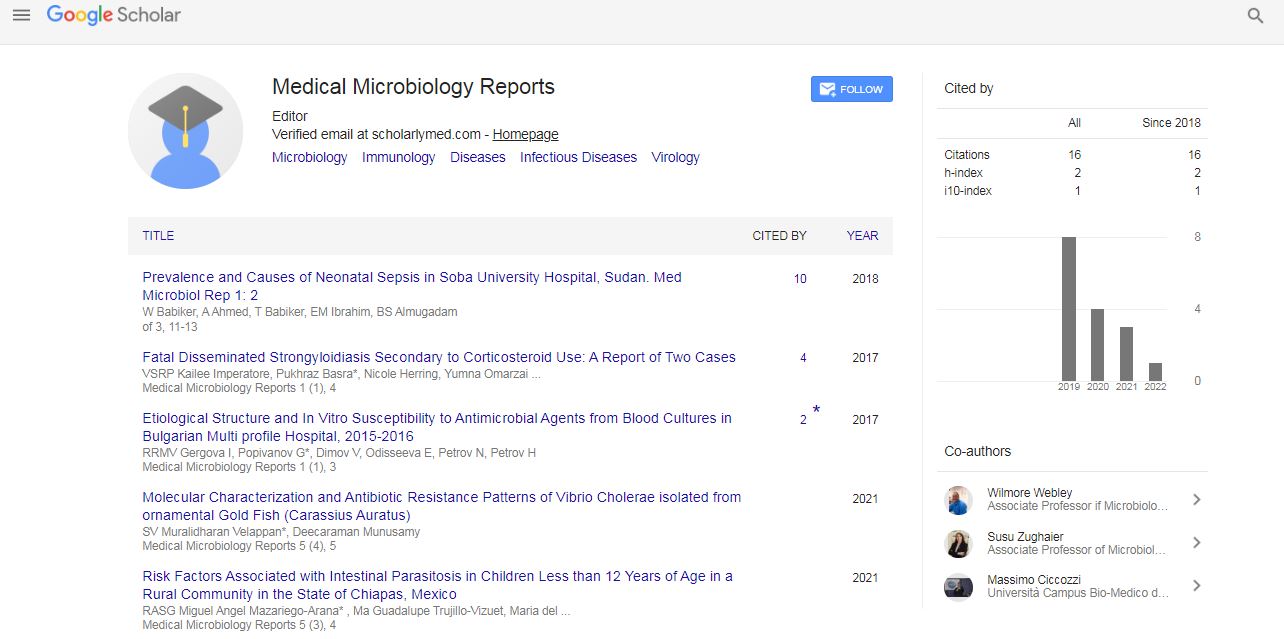Perspective, Med Microbiol Rep Vol: 7 Issue: 1
Strongyloides Stercoralis: Causes a Range of Clinical Manifestations
Grandy Zimie*Department of Molecular Medicine, Harbor-UCLA Medical Center, Torrance, CA,USA
*Corresponding Author: Grandy Zimie
Department of Molecular Medicine,
Harbor-UCLA Medical Center, Torrance, CA, USA
E-mail: Zimieandy11@gmail.com
Received date: 27 February, 2023, Manuscript No. MMR-23-93591;
Editor assigned date: 01 March, 2023, PreQC No. MMR-23-93591(PQ);
Reviewed date: 15 March, 2023, QCNo MMR-23-93591;
Revised date: 22 March 2023, Manuscript No. MMR-23-93591(R);
Published date: 31 March 2023 DOI: 10.4172/MMR.1000329.
Citation: Zimie G (2023) Strongyloides Stercoralis:Causes a Range of C.l inical Manifestations . Med Microbiol Rep 7:1.
Description
Strongyloides stercoralis is a parasitic nematode that infects an estimated 30-100 million people worldwide. The parasite has a unique life cycle that allows it to persist for years in the human host without causing any symptoms. This study provides an overview of the life cycle, clinical manifestations, and diagnosis of Strongyloides stercoralis infection.
Strongyloides stercoralis is a soil-transmitted parasitic nematode that infects humans and other mammals. The parasite is endemic in tropical and subtropical regions and is commonly found in areas with poor sanitation and hygiene. Strongyloides stercoralis infection is often overlooked due to its ability to persist for years in the human host without causing any symptoms. However, the infection can cause severe complications in immunocompromised individuals, including disseminated strongyloidiasis, which has a mortality rate of up to 87%.
Life cycle
The life cycle of Strongyloides stercoralis is unique among parasitic nematodes. The adult female parasite lives in the small intestine of the human host, where it lays eggs that hatch into larvae. The larvae can either develop into free-living males and females, which mate and produce more eggs, or they can develop into infective filariform larvae that can penetrate the skin or mucous membranes of the host. Once inside the host, the filariform larvae migrate to the lungs, where they are coughed up and swallowed, and then develop into adult parasites in the small intestine.
Clinical manifestations
Strongyloides stercoralis infection can cause a range of clinical manifestations, from mild gastrointestinal symptoms to severe disseminated disease. In immunocompetent individuals, the infection is often asymptomatic or causes mild symptoms such as abdominal pain, diarrhea, and urticaria. In immunocompromised individuals, the infection can cause hyperinfection syndrome or disseminated strongyloidiasis, which is characterized by widespread dissemination of the parasite to various organs, including the lungs, liver, and central nervous system. Disseminated strongyloidiasis can cause severe complications, such as meningitis, sepsis, and respiratory failure, and has a high mortality rate.
Diagnosis
The diagnosis of strongyloides stercoralis infection can be challenging, as the parasite can be difficult to detect. The gold standard for diagnosis is the detection of larvae in stool or duodenal aspirate specimens. However, the sensitivity of stool examination is low, and multiple samples may be required to detect the parasite. Serological tests, such as Enzyme-Linked Immunosorbent Assay (ELISA), can also be used to detect antibodies to Strongyloides stercoralis, but they are not always reliable, especially in immunocompromised individuals.
Treatment
The treatment of strongyloides stercoralis infection involves the use of anthelmintic medications, such as ivermectin or albendazole. The choice of medication and duration of treatment depend on the severity of the infection and the immune status of the patient. In immunocompetent individuals with mild to moderate infection, a single dose of ivermectin or albendazole is usually sufficient. In immunocompromised individuals or those with disseminated disease, prolonged treatment with multiple doses of medication may be necessary.
Prevention
The prevention of Strongyloides stercoralis infection involves improving sanitation and hygiene practices in endemic areas. Measures such as wearing shoes and practicing good hand hygiene can help prevent skin penetration by infective larvae. Additionally, screening and treating high-risk individuals.
 Spanish
Spanish  Chinese
Chinese  Russian
Russian  German
German  French
French  Japanese
Japanese  Portuguese
Portuguese  Hindi
Hindi 
